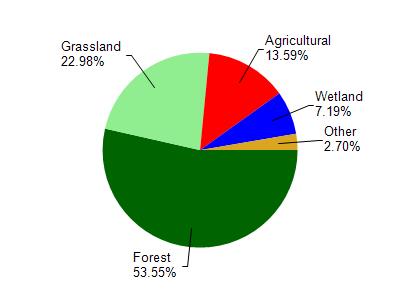Richland
Yes
No
No
Fish and Aquatic Life
Overview
Jimtown Branch is a small spring-fed Class I trout stream tributary to Knapp Creek and has a naturally reproducing brook trout population. The creek was monitored as a 2000 baseline stream. Portions of the stream have been channelized, resulting in some habitat loss.
From: Ripp, Coreen, Koperski, Cindy and Folstad, Jason. 2002. The State of the Lower Wisconsin River Basin.
PUBL WT-559-2002. Wisconsin Department of Natural Resources, Madison, WI.
Date 2002
Author Cynthia Koperski
Overview
Jimtown Branch is a small spring-fed Class II trout stream tributary to Knapp Creek. It is recommended that the stream be upgraded to Class I trout stream and exceptional resource water, (ERW), due to the presence of naturally reproducing brook trout. The creek was monitored as a 2000 baseline stream. Portions of the stream have been channelized, resulting in some habitat loss.
Date 2001
Author Aquatic Biologist
Historical Description
Jimtown Branch is a small spring-fed Class II trout stream (WDNR. 1980) tributary to
Knapp Creek. Water quality is considered good, although we have no water quality or
stream biology data. Portions of the stream were channelized in the past, resulting in
some habitat loss. A preliminary assessmetat of the stream and its sub-waterslned in
1985 indicated it had a medium to high potential for nonpoint source water pollution
problems (Eagan. 1985).
Date 1994
Author Surface Water Inventory Of Wisconsin
Condition
Wisconsin has over 84,000 miles of streams, 15,000 lakes and milllions of acres of wetlands. Assessing the condition of this vast amount of water is challenging. The state's water monitoring program uses a media-based, cross-program approach to analyze water condition. An updated monitoring strategy (2015-2020) is now available. Compliance with Clean Water Act fishable, swimmable standards are located in the Executive Summary of Water Condition in 2018. See also the 'monitoring and projects' tab.
Reports
Management Goals
Wisconsin's Water Quality Standards provide qualitative and quantitative goals for waters that are protective of Fishable, Swimmable conditions [Learn more]. Waters that do not meet water quality standards are considered impaired and restoration actions are planned and carried out until the water is once again fishable and swimmable
Management goals can include creation or implementation of a Total Maximum Daily Load analysis, a Nine Key Element Plan, or other restoration work, education and outreach and more. If specific recommendations exist for this water, they will be displayed below online.
Monitoring
Monitoring the condition of a river, stream, or lake includes gathering physical, chemical, biological, and habitat data. Comprehensive studies often gather all these parameters in great detail, while lighter assessment events will involve sampling physical, chemical and biological data such as macroinvertebrates. Aquatic macroinvertebrates and fish communities integrate watershed or catchment condition, providing great insight into overall ecosystem health. Chemical and habitat parameters tell researchers more about human induced problems including contaminated runoff, point source dischargers, or habitat issues that foster or limit the potential of aquatic communities to thrive in a given area. Wisconsin's Water Monitoring Strategy was recenty updated.
Grants and Management Projects
| Project Name (Click for Details) | Year Started |
|---|
|
|
Monitoring Projects
| WBIC | Official Waterbody Name | Station ID | Station Name | Earliest Fieldwork Date | Latest Fieldwork Date | View Station | View Data |
|---|
| 1210000 | Jimtown Br | 10008053 | Jimtown Branch Station 1-Shady Rd | | | Map | Data |
| 1210000 | Jimtown Br | 10033876 | Jimtown Branch at CTH KK | 1/1/2015 | 1/1/2015 | Map | Data |
| 1210000 | Jimtown Br | 10033875 | Jimtown Branch at CTH U | 1/1/2015 | 1/1/2015 | Map | Data |
|

Watershed Characteristics
Jimtown Br is located in the Knapp Creek watershed which is 158.64 mi². Land use in the watershed is primarily forest (53.60%), grassland (23%) and a mix of agricultural (13.60%) and other uses (9.90%). This watershed has 395.31 stream miles, 126.86 lake acres and 6,498.05 wetland acres.
Nonpoint Source Characteristics
This watershed is ranked Medium for runoff impacts on streams, Not Ranked for runoff impacts on lakes and High for runoff impacts on groundwater and therefore has an overall rank of High. This value can be used in ranking the watershed or individual waterbodies for grant funding under state and county programs.However, all waters are affected by diffuse pollutant sources regardless of initial water quality. Applications for specific runoff projects under state or county grant programs may be pursued. For more information, go to surface water program grants.